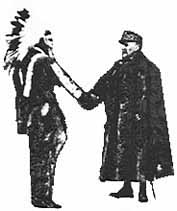

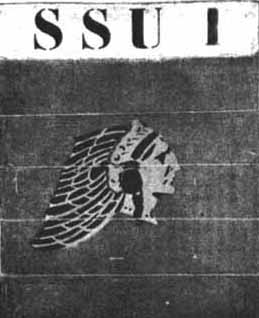
Introduction
American Indians were so much part of the American collective unconscious that, in the early part of the United States' engagement in the War, several German battleships that had been seized in American harbors were given Indian namesthe "Hamburg" became the "Powhatan," the "Rhein" became the "Susquehanna," the "Prinzess-Irene" became the "Pocahontas," and the "Friedrich-der-Gross" became the "Huron."1
Stereotyped images of American Indian soldiers during the Great War are essentially to be found in American newspaper articles. At the same time, the visual representations of Indians as a unit insignia for a corps of American volunteers before 1917, for the 2d Division of the American Expeditionary Forces, as artistic ornamentation in a quarry inhabited by American soldiers, and on American memorials, proved also very interesting.
1. The "Redskins" Against the "Huns"
"You Will Meet Enemy More Savage Than We Were."
Father Tells Son on the Way to War.
The Stars and Stripes, 1918.2
The apparent contradiction of American Indians fighting alongside the army they used to fight against was widely used by journalists in search of material for sensational stories. If, by 1917, American Indians were no longer threatening and were thus recognized as human beings, they had been dangerous enemies in the past who were at best considered to be noble warriors, at worst, bloodthirsty savages. For journalists, the Great War presented the interest of displaying American Indians in conditions of war, but on neutral ground and against another enemy, a "savage" one: the Hun. It did not take them long to revive the noble warrior.
The interest of all articles written about American Indian soldiers' faits de guerre during the Great War is that most of them were mere rewrites of government releases.3 They mirrored the "official"or at least authorizedimage of the Indian and were part of war propaganda. Propaganda, to be useful, calls for simple images: the simpler the message, the better it is received. In other words, propaganda is based on the use of stereotypes. Inferiorizing the enemy has always been part of propaganda in times of war. World War I was no exception, on the contrary.4 I will thus begin my analysis by the stereotype of the German soldier, as well as by the image of the Indian held by German soldiers.
For this study, I used quotations from articles published in other works, and all four articles on American Indian soldiers to be found in The Stars and Stripes during its sixteen months of existence in France. The Stars and Stripes was the official publication of the American Expeditionary Forces. This weekly newspaper, allegedly "free from propaganda," was printed in France from February 1918 to June 1919 and was intended to be "an inspiration for the soldier in France."5
In my research in French newspapers--Le Miroir, L'Illustration, J'ai vu, Le Monde illustré--I was only able to find two articles directly relating to the participation of American Indians in the Great War, both published in the Miroir (those referred to when I spoke of American Indian recruiting agents). More than articles, the Miroir published pictures accompanied by extensive captions.
A serialized novel by Charles Derennes"Les Conquérants d'idoles"published in the French weekly J'ai vu6 during six weeks from May 9 to June 20, 1919, although not related to the war, is interesting because, whereas the story was supposed to take place in Chile, the Indians depicted in all the illustrations by Charles Genty were degenerate, sad looking, and drunk Plains Indians, crowned by drooping feather bonnets. The illustrations perfectly matched the racist tone of the novel where one of the Indian characters was called "The-One-Who-Empties-Bottles," and whose Indians were assimilated to monkeys:
"Le cacique des environs de Copiapo, notre cher Vide-Bouteille, ne nous avait pas menti en nous disant que les Agzcéaziguls ressemblaient à ses sujets et à lui-mâme; à vrai dire, entre eux et des singes, il n'y avait pas le saut d'un fossé"...7
1.2. The German Seen by the Americans and the American Indian Seen by the German
Most of the articles used for my study reporting on Indians' heroism during the Great War also speak about German barbarism. German soldiers, by some mysterious slip back into the past, have become either Huns or Prussians. This was no American invention and there are innumerable examples of articles in French newspapers where the Germans are referred to as "Huns," "barbares," "Prussiens," or "Boches." In the entry of November 29, 1918 of his later-published diary, a French officer writes that "with the Boche people, we find ourselves before an inferior form of humanity."8 He goes on to say "the closer the outcome of this war approaches, the more one discovers the ugliness, the hereditary faults, the bestiality of instinct which the Germanic race has been hiding under the powdery make-up of its Kultur."9 In 1918, the Eastern Cherokees considered showing an anti-German film at their annual fair called In the Wake of the Huns.10
In 1961, German author Ernst Jünger published a novel--In Stahlgewittern--based on the diary he wrote during the Great War.11 On June 20, 1916, the young soldier was given the mission to go listen to what was happening in the enemy's trenches:
"Nous parcourûmes le début de la distance pliés en deux, puis nous rampâmes l'un à côté de l'autre à travers la végétation luxuriante des approches des lignes anglaises. Des souvenirs de ma classe de troisième et de Karl May me revinrent en mémoire, tandis que je me traînais ainsi sur le ventre à travers des herbes couvertes de rosée et des chardons en broussaille, attentif à ne pas provoquer le moindre froissement, car, à cinquante mètres devant nous, le boyau anglais se détachait comme un trait noir de la pénombre." 12
Just as Winnetou in the Karl May's novels he read when he was a boy, the young German soldier crawled in the dark among herbs and bushes, regardlessyet consciousof the enemy, only fifty meters from him.
It was often reported that German soldiers, most of whom had grown up reading the many books of Karl May, were scared at the idea that "redskins" were fighting against them. This might have been partly true, but of course, such an idea was extensively exploited by newspapers as a real "find" in popular folklore. Here is what the Stars and Stripes reported in May 1919:
"An American officer, captured by the Germans in the battle of St. Mihiel, was surprised to find himself interrogated not on his division movements or objectives, but on how many Indians there were in the units opposing the Boches in that sector."
This, and another incident in which it became known that an extra force of snipers had been put into the lines to come with the American aborigines, showed to what extent the Indians were feared by the Germans.13
In a preceding article from the same newspaper, the journalist reported that "when the end of the fight [opposing American Indian and German soldiers] was nearing, Prussian Guards could be seen running over the hill tops, casting away their rifles, knapsacks, canteenssacrificing everything for speed."14
Pierre Berton, who wrote a book on the major battle the Canadians engaged in during WWI--Vimy--reported what a German prisoner told his Canadian jailers: "His officers had warned their men, he said, not to be taken prisoner as the Canadians were all Red Indians who would scalp them."15
1.3. The Everlasting Stereotypes, and a New One
There are numerous stories of Indian heroism during the Great War, and most of them recalled that Indians were born-warriors"War seems the natural business of the Indian."16 In this process, German and Indian soldiers were often put in the same category of savages, though of course, Indians were always the good savages. In November 1918, an article began with this evocative sentence: "It was the Prussian Guard against the American Indian on the morning of October 8 in the hills of Champagne."17
Nearly all articles also emphasized that if the methods that Indians used in fighting were the traditionalsavageones, their ideals on the contrary, were highly civilized. Or maybe it would be better to say that, through their combat against "an enemy more savage than the red man,"18 they acquired the basics of civilization. And after all, even their methods were not that savage, as Chief Don White Eagle pointed out: "To be tomahawked cleanly is a much easier way to die than lots of the German methods of warfare."19
Newspaper articles during the war were so enthusiastic about this aspect of the American Indian participation in the war that some journalists went as far as revising famous sayings about Indians"Lo, the poor Indian, no longer poor, is a good Indian," or "a good Indian is one who is very much alive."20
Even though most American Indian soldiers were educated young men, who knew perfectly well how to read and write, most newspaper-Indian soldiers hardly knew how to speak English. The journalist who wrote about Private Ross, a Ute Indian from Arizona, explained that "he [said] 'Ugh' for 'Yes, sir,' and [shook] his head for 'No, sir.'" Private Ross, in one case of great excitement, "forgot himself and uttered the ancient tocsin of his race." Yet, Private Ross also had great scouting qualities and it brought him the admiration of the company whose members were not long in calling him... "Chief."21
One of the foremost qualities of Indian soldiers was their modesty. They would not "run to the newspapers to declaim what [they] did to win the war." They were just noble and quiet warriors. The same journalist knew that they would instead "take up their routine duties on the reservation again, as quietly as a turtle's head sinks below the surface of a mill pond." This poetic image leaves to the reader's imagination what the "mill pond" might represent and what the action of "sinking below" might refer to.22
The 36th Division was composed of the Oklahoma and Texas National Guards.23 According to a journalist, one of the companies of the 36th was made up of Texas and Oklahoma rangers and oil men, who had brought from Camp Bowie, Wyoming, their title of "Millionaire Company." "Collectively, they owned many square miles of the richest oil and mineral lands of Oklahoma, and back home, there were thousands of dollars in royalties piling up everyday for the buying of Liberty Bonds."24 Oil had first been exploited in Oklahoma in 1896 and, from 1903 to 1912, Osage Indians received $2,734,986 in royalties. It quickly became embarrassing to know that all these riches lay on Indian land. By 1924, when still more oil was discovered on Osage territory, it was considered that the "Indian is not equipped to handle or conserve a considerable sum (...) hence Uncle Sam devised a plan to keep a check on extravagance as far as possible."25 In 1918, the journalist who had written about the "Millionaire company" had thus unwittingly inaugurated an era where the Osage would be described as rich and consequently incompetent Indians.
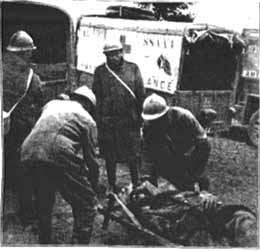 From September 1914 to September
1917, young Americans who were willingand who could affordto
see action in France while their country was still neutral signed
up for volunteer service driving ambulances. After April 1915,
such service became organized as squads or sections attached directly
to French combat divisions through the Army Automobile Service.
Several ambulance sections were thus organized as part of the
"Sections sanitaires étrangères" of the
French Army.26 Section One of the American
Ambulance Field Service was one of the oldest of these "sections
sanitaires étrangères,"having begun its service
in January 1915.27 On July 29, 1916, Jean Tardieu,
a Frenchman attached to this unit, designed an Indian head as
the emblem for the vehicles of Section One, "taking his lines
from the regular Indian on the $5 gold-piece."28
From September 1914 to September
1917, young Americans who were willingand who could affordto
see action in France while their country was still neutral signed
up for volunteer service driving ambulances. After April 1915,
such service became organized as squads or sections attached directly
to French combat divisions through the Army Automobile Service.
Several ambulance sections were thus organized as part of the
"Sections sanitaires étrangères" of the
French Army.26 Section One of the American
Ambulance Field Service was one of the oldest of these "sections
sanitaires étrangères,"having begun its service
in January 1915.27 On July 29, 1916, Jean Tardieu,
a Frenchman attached to this unit, designed an Indian head as
the emblem for the vehicles of Section One, "taking his lines
from the regular Indian on the $5 gold-piece."28
In April 1916, the Lafayette Escadrillea unit of volunteer American pilotswas created and drew many of its 38 members from the Field Service sections. One of its founders was the group's medical director, Edmund Gros.29 In the Autumn of 1916, the Indian headslightly modified from the Section One version, more aggressive lookingwas chosen as the insignia of the Escadrille: "The wild Sioux, with a menacing look about him, drew everyone's eye to the fuselage where it was painted."30
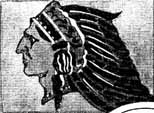 |
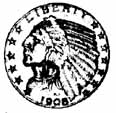 |
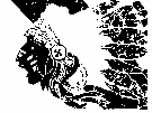 |
The Second Division of the American Expeditionary Forces arrived in France on October 20, 1917. Its insignia was a Plains Indian head on a background of a star and shield. The color varied according to the unit. This design had been created by a truck driver.31
Life on the front was not only hard and dangerous, it was also monotonous and lonely, especially for North American soldiers so far away from home. During the long moments spent in the rear, waiting for another attack, the soldiersEnglish, French, Canadian, German, etc.tried to recreate ephemeral homes, fixing up these very precarious dwellings as best they could. On both sides of the Chemin-des-Dames, caves which had been active quarries were taken over by French, English, and German soldierssome of them having furnished lodgings to all of them as the front moved back and forth. The traces of the military cave dwellers of the Great War can very well be seen today and show that all soldiers made the most out of their underground lodgings. In the Nanteuil-la-Fosse quarry of the Chemin-des-Dames, for example, inhabited by the American 103d Infantry Regiment between February and March 1918, the soldiers built a bread oven, a shrine, put tar paper on the wall to warm up the atmosphere, and unleashed their artistic talents on the wallsdrawing graffiti and carving bas-reliefs.32
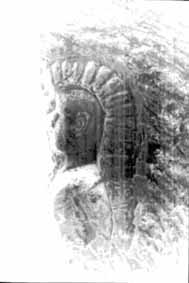 The subjects evoked in the graffiti
and carvings are very diverse, representing the different interests
of the artist-soldiers. Yet they do fall into some general categories
which may be illustrated by the example of Nanteuil-la-Fosse.
First there are all the carvings representing the insignia of
the units which stayed in the quarryCompanies F, G, and H
of the 103d Infantry Regiment of the 26th "Yankee" Division.
The 26th Division was composed of New England National Guards.33 According to Pierre Samain, the insignia of
the 26th Division (a big letter Y in a rectangle) was first designed
in this quarry. Then there is the group of diverse and personal
carvings, such as trademarks coming from some western ranches,
naked women, cabalistic signs, etc. Finally comes the group of
carvings which evoke, in one way or another, the general idea
of the United States. One represents Lincoln, another Wilson,
still another the Uncle Sam with his big hat, several flags and
eagles, and ... Indian heads.
The subjects evoked in the graffiti
and carvings are very diverse, representing the different interests
of the artist-soldiers. Yet they do fall into some general categories
which may be illustrated by the example of Nanteuil-la-Fosse.
First there are all the carvings representing the insignia of
the units which stayed in the quarryCompanies F, G, and H
of the 103d Infantry Regiment of the 26th "Yankee" Division.
The 26th Division was composed of New England National Guards.33 According to Pierre Samain, the insignia of
the 26th Division (a big letter Y in a rectangle) was first designed
in this quarry. Then there is the group of diverse and personal
carvings, such as trademarks coming from some western ranches,
naked women, cabalistic signs, etc. Finally comes the group of
carvings which evoke, in one way or another, the general idea
of the United States. One represents Lincoln, another Wilson,
still another the Uncle Sam with his big hat, several flags and
eagles, and ... Indian heads.
There are two Indian heads in the Nanteuil-la-Fosse quarry. One seems to be a direct copy of the Quarter and Half Eagle coins, though the low quality of the design makes it difficult to tell exactly. The other one's headdress makes it believeable that it could be an Iroquois, while it could also be an awkward attempt to represent a Plains Indian. Hervé Vatel, in a Master's thesis on the graffiti in the trenches, reports having seen another (Plains) Indian head carving, without specifying exactly where. Ironically, he classifies it in a section "History and culture of a country" along with, and on the same page as a carving of Buffalo Bill.34 Finally, I was told about the existence of an Indian head carving in the Château de Penin (Pas-de-Calais), which was occupied during the Great War by Canadian soldiers. Once again, it is a typical Plains Indian profile and looks very much like the image on the American Indian Head penny.35
It thus appears that, for these companies where there were probably no Native Americans, at least not from the Plains, the Indian head came to represent the essence of the country they missed so much, in much the same way as America was represented by an Indian woman in the 19th century.
 After the Great War, eight memorials
were erected in France by the American government as a tribute
to its soldiersat Bellicourt (Aisne), Cantigny (Somme), Château-Thierry
(Aisne), Montfaucon (Meuse), Montsec (Meuse), Brest (Finistère),
Sommepy (Marne), and Tours (Indre-et-Loire).36
The thousands of crosses of the six WWI American cemeteries in
France also remain as moving testimonies of the toll paid by the
United States during the conflictcemeteries of the Somme
(Bony), of the Aisne-Marne (Belleau), of the Oise-Aisne (Fère-en-Tardenois),
of the Meuse-Argonne (Romagne-sous-Montfaucon), of Saint-Mihiel,
and of Suresnes.37
After the Great War, eight memorials
were erected in France by the American government as a tribute
to its soldiersat Bellicourt (Aisne), Cantigny (Somme), Château-Thierry
(Aisne), Montfaucon (Meuse), Montsec (Meuse), Brest (Finistère),
Sommepy (Marne), and Tours (Indre-et-Loire).36
The thousands of crosses of the six WWI American cemeteries in
France also remain as moving testimonies of the toll paid by the
United States during the conflictcemeteries of the Somme
(Bony), of the Aisne-Marne (Belleau), of the Oise-Aisne (Fère-en-Tardenois),
of the Meuse-Argonne (Romagne-sous-Montfaucon), of Saint-Mihiel,
and of Suresnes.37
At the Oise-Aisne cemetery, in Fère-en-Tardenois (Aisne), there is a memorial in form of a curving colonnade and built of rose sandstone. On the top of one of the pillars, a Plains Indian head is carved and could be the insignia of the Second Division.38 This Indian head insignia may exist in other American memorials because many of them display unit insignia, yet this still remains to be verified.39
Even more interesting for us is the Tours Memorial, commemorating the work of the 650,000 men of the Services of Supply of the American Expeditionary Forces. Described as a "handsome fountain of white stone and bronze with appropriate sculpture" by the brochure of the American Battle Monuments Commission, this monument features a kneeling Indian holding an eagle on his arm.40 It would be interesting to know by which criteria this sculpture was deemed "appropriate." Anyway, eagle and Indian, both incarnating wildness, freedom and physical prowess, thus came to symbolize the participation of the United States in the Great War.
Two images of the Indian were prevalent in the Great War. One was directly linked to the American Indian's participation in the war as a soldier and represented him as a brave yet primitive warrior. This image was the continuation of an old stereotype which found but new momentum in the circumstance of the war.
The other image had no link to the military service of American Indians. It was that used as unit insignia, on graffiti in trenches or quarries, and on American memorials. Although it may seem contradictory given the past of Indian-White relations in the United States, the Plains Indian headand the athletic Indian figure of the Tours monumentcame to symbolize U.S. participation in the Great War. True, the American Indian was the only real "native" American and this may be part of the reason why he was chosen as the most typically American image to represent America. But this mainly shows how strong the Indian image is in the American collective unconscious. It is a complex mixture of feelings of guilt (towards the past treatment of American Indians), feelings of superiority (American Indians have yet to become civilized), admiration for American Indian traditions and proximity to nature (some kind of a lost Paradise), memories of childhood (reading dime novels or enjoying Wild West Shows), and many other elements. Carl Jung after having observed the importance of the Indian symbol among his American patients, wrote:
"... it was only in the course of very thorough and deep analysis that I came upon symbols relating to the Indian. The progressive tendency of the unconscious, as expressed for instance in the hero-motif, chooses the Indian as its symbol, just as certain coins of the Union bear an Indian head. This is a tribute to the once-hated Indian, but it also testifies to the fact that the American hero-motif chooses the Indian as an ideal figure."41
Part II, WWI and its Consequences: Chapter IV: Consequences of the War
1 . "La Préparation américaine." L'Illustration. February 23, 1918, n°3912, p.173.2 . The Stars and Stripes. 1:4, March 1, 1918, p.2
3 . Russel L. Barsh. "American Indians in the Great War." Ethnohistory. 38:3 (Summer 1991), p.285.
4 . Marc Ferro. La Grande Guerre, 1914-1918. Paris: Folio/Gallimard, 1990 (1969), pp.215-22.
5 . The Stars and Stripes. A Complete File of the Stars and Stripes, Printed in France from February 8, 1918 to June 13, 1919. Washington, DC: National Tribune Corporation, Title page.
6 . Charles Derennes (text) &Charles Genty (illustrations). J'ai vu. 5:202 to 5:208. May 9, 1919; May 16, 1919; May 23, 1919; May 30, 1919; June 6, 1919; June 13, 1919; June 20, 1919.
7 . J'ai vu. 5:206. June 6, 1919, p.319.
8 . "Avec le peuple boche on se trouve devant une humanité inférieure." Lieutenant-colonel Rousset. La guerre au jour le jour. Vol.6 (Juin 1918-28 juin 1919). Paris: Tallandier, 1920, p.365.
9 . "Plus le dénouement de cette guerre approche, et plus se découvrent les hideurs, les tares héréditaires, la bestialité des instincts que la race germanique cachait sous les apparences maquillées de sa kultur." Ibid., p.365
10 . John R. Finger. Cherokee Americans. The Eastern Band of Cherokees in the Twentieth Century. Lincoln &London: University of Nebraska Press, 1991, p.41.
11 . Ernst Jünger. Orages d'Acier. French translation by Henri Plard from German original. Paris: Christian Bourgois/Le Livre de Poche, 1993 (1970), p.5.
12 . Ibid., p.93. This young man had probably read these lines written by Karl May: "Je m'aplatis alors dans l'herbe et, mon couteau entre les dents, je me mis à ramper vers la tente du chef. A chaque pas, maintenant, un nouveau danger me guettait. Mais je n'étais pas seul. De l'autre côté du camp, Winnetou, se glissant dans les hautes herbes, se dirigeait vers le mâme but..." Charles May. Les Pirates du rail. Paris: Flammarion, 1948, p.80.
13 . Stars and Stripes. 2:17, May 30, 1919, p.3
. 14 . Stars and Stripes, 1:40, November 8, 1918, p.8.
15 . Pierre Berton. Vimy. Canada: Penguin Books, 1986, p.241.
16 . Washington Sunday Star. August 25, 1918, quoted by Russel Barsh. "American Indians in the Great War." Ethnohistory. 38:3 (Summer 1991), p.289.
17 . Stars and Stripes, 1:40, November 8, 1918, p.8.
18 . Stars and Stripes, 1:4, March 1, 1918, p.2.
19 . Russel Barsh, op. cit., p.292.
20 . Baltimore Star, March 4, 1918 and Newark Star Eagle, July 26, 1918. Ibid., pp.286, 289.
Alexander Pope, in 1773-1774, wrote in An Essay on Man:
"Lo, the poor Indian whose untutor'd mind
Sees God in clouds, or hears him in the wind;
His Soul proud Science never taught to stray
Far as the solar walk or milky way;"
Quoted by Robert F. Berkhofer, Jr. "White Conceptions of Indians." In "History of Indian-White Relations." Ed. Wilcomb E. Washburn. Vol. 4. of Handbook of North American Indians. Ed. William C. Sturtevant. Washington, D.C.: Smithsonian Institution, 1988, p.528. General Philip H. Sheridan had originally said to Tosawi, a Comanche Chief: "the only good Indians I ever saw were dead." These words became the American aphorism "the only good Indian is a dead Indian." Richard Drinnon. Facing West: The Metaphysics of Indian-Hating and Empire-Building. New York: Schocken Books, 1990 (1980), p.539.
21 . Stars and Stripes, 1:33, September 20, 1918, p.6.
22 . Stars and Stripes, 2:17, May 30, 1919, p.1, 3.
23 . "Les Américains au combat." In 1917-1987: 70e Anniversaire de l'entrée en guerre des Etats-Unis d'Amérique. Secrétariat d'Etat aux Anciens Combattants, 1987.
24 . Stars and Stripes, 1:40, November 8, 1918, p.8.
25 . Isaac F. Marcosson. The Black Golconda: The Romance of Petroleum. New York &London: Harper &Brothers, 1924, pp. 198-99, 203.
26 . J. Paulding Brown. "The First Months of the American Ambulance, Sept. 1914 to May 1915." In The History of the American Field Service, 1922-1955. George Rock. New York: Platen Press, 1956, pp.9-14.
27 . History of the American Field Service in France, "Friends of France" 1914-1917 Told by Its Members. Vol.1. Boston &New York: Houghton Mifflin, 1920, p.81.
28 . William York Stevenson. At the Front in a Flivver. Boston: Houghton Mifflin, 1917, p.145. Thank you to Bill Foley for having given me this reference.
29 . Jody Brinton. "The History of the American Field Service." Vol.VIII. Typescript, 1988, page unknown, A.F.S. Archives, New York, p.45.
30 . "Le farouche Sioux, à l'air menaçant, attira tous les regards sur le fuselage où il était peint." Lieutenant-colonel Georges Thenault. L'Escadrille Lafayette, Avril 1916-Janvier 1918. Paris: Hachette, 1939, p.75.
31 . The Stars and Stripes, January 17, 1919.
32 . All information on the Nanteuil-la-Fosse quarry comes from a visit of this quarry (March 8, 1994), brilliantly guided by Pierre Samain, a specialist of the Chemin-des-Dames.
33 . "Les Américains au combat." In 1917-1987: 70e Anniversaire de l'entrée en guerre des Etats-Unis d'Amérique. Secrétariat d'Etat aux Anciens Combattants, 1987.
34 . Hervé Vatel. "Le graffiti des tranchées. Une approche plastique." Maîtrise d'Arts plastiques, UFR d'Arts plastiques et Sciences de l'Art, Université de Paris I, October 1990.
35 . Benoît Decock, a student at the University of Amiens working on a Master's Thesis on the graffiti in the trenches, gave me this information.
36 . American Memorials and Overseas Military Cemeteries. (Brochure). Washington, D.C.: The American Battle Monuments Commission, 1989.
38 . Annette Becker, a specialist of the Great War and particularly of its memorials, showed a slide of this Indian head in a paper she gave in Paris"La foi des soldats pendant la Première Guerre mondiale." Société d'Etudes Nord-Américaines (S.E.N.A.), November 25, 1994. She later gave me a written confirmation of this information.
39 . American Memorials and Overseas Military Cemeteries. (Brochure). Washington, D.C.: The American Battle Monuments Commission, 1989.
41 . Carl G. Jung. Civilization in Transition. English translation by R.F.C. Hull from German original. In The Collected Works of C.G. Jung. Eds. Herbert Read, Michael Fordham, &Gerhard Adler. Vol. X. London: Routledge &Kegan Paul, 1964, p.47.